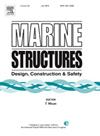An experimental study on the strain responses of blades and struts of a 5MW semi-submersible floating vertical-axis wind turbine
IF 4
2区 工程技术
Q1 ENGINEERING, CIVIL
引用次数: 0
Abstract
A blade and strut strain sensing system is utilized in this study for a floating vertical-axis wind turbine (VAWT) to monitor and measure dynamic strains in the wave basin model test. The floating VAWT concept consists of a 5MW H-type rotor with three straight blades and a semi-submersible platform. The strain sensing system combines the advantages of Fiber Bragg Grating (FBG) sensors and a fiber optic rotary joint (FORJ). Subsequently, a series of model tests are carried out to investigate the strain response characteristics of blades and struts under various environmental conditions. The results show that the strains on blades and struts are affected by wave, wind, and rotor rotational speed, among which the influence of waves is minor. Under combined wind, rotational speed, with/without wave conditions, the increasing wind speed and rotational speed can lead to increases in mean values and oscillations of blade and strut strains, as well as nP (n times per revolution) components. Besides, blade strain is primarily influenced by the 1P (once-per-revolution) component, while strut strain is mainly affected by the 2P (twice-per-revolution) component for the present FBG sensors arrangement. In summary, this study offers valuable insights into the dynamic strain characteristics of blades and struts of floating VAWT under different environmental conditions, contributing to the advancement of floating VAWT model test technology and the validation of future numerical models.
5MW半潜式浮式垂直轴风力机叶片和支板应变响应试验研究
本文采用叶片与支板应变传感系统对浮动垂直轴风力机(VAWT)进行了波盆模型试验中的动态应变监测与测量。浮动VAWT概念由一个5MW的h型转子和三个直叶片和一个半潜式平台组成。该应变传感系统结合了光纤布拉格光栅(FBG)传感器和光纤旋转接头(FORJ)的优点。随后,进行了一系列模型试验,研究了叶片和支板在各种环境条件下的应变响应特性。结果表明:波浪、风和转子转速对叶片和支板应变均有影响,其中波浪的影响较小;在组合风、转速、有/无波条件下,风速和转速的增加会导致叶片和支板应变的平均值和振荡的增加,以及nP (n次/转)分量的增加。此外,在目前的FBG传感器布置中,叶片应变主要受1P(每转一圈)分量的影响,而支柱应变主要受2P(每转两圈)分量的影响。综上所述,本研究对浮式VAWT叶片和支板在不同环境条件下的动态应变特性提供了有价值的见解,有助于推进浮式VAWT模型试验技术的发展和对未来数值模型的验证。
本文章由计算机程序翻译,如有差异,请以英文原文为准。
求助全文
约1分钟内获得全文
求助全文
来源期刊

Marine Structures
工程技术-工程:海洋
CiteScore
8.70
自引率
7.70%
发文量
157
审稿时长
6.4 months
期刊介绍:
This journal aims to provide a medium for presentation and discussion of the latest developments in research, design, fabrication and in-service experience relating to marine structures, i.e., all structures of steel, concrete, light alloy or composite construction having an interface with the sea, including ships, fixed and mobile offshore platforms, submarine and submersibles, pipelines, subsea systems for shallow and deep ocean operations and coastal structures such as piers.
 求助内容:
求助内容: 应助结果提醒方式:
应助结果提醒方式:


